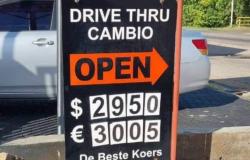Labor, the Greens and most of the teals like the idea of splashing taxpayer money on green ventures, similar to the Coalition indulgences on dams, inland rail, commuter carparks and Snowy Hydro 2.0.
And whatever the energy and economic merits of nuclear power, the Coalition will offer similar huge subsidies for nuclear.
Hard lessons have not been learned from all sides on the Snowy pumped hydro project blowing out from an estimated $2 billion to $12 billion.
There is obvious political appeal for Labor before an election to pledge to build solar panels in the coal heartland of the Hunter Valley in NSW.
But the economic policy case is extremely weak for supporting the domestic solar panel industry, which is backed by the likes of AGL Energy, billionaire Mike Cannon-Brookes and former prime minister Malcolm Turnbull.
Australia has no obvious international comparative advantage.
The price of solar panels has plunged due to China flooding the world market.
China produces about 90 per cent of the world’s solar panels. It has huge economies of scale and cheaper labor.
The global price of solar panels has crashed from above $US1 per watt a decade ago to US11¢, BloombergNEF data shows.
In a fully-stretched economy, draining capital and labor from more productive uses just adds to inflation pressures.
The Financial Times reported this week: “Solar panels have become so cheap that they are being used to build garden fences in the Netherlands and Germany, as a boom in Chinese production saturates the global market.”
European solar panel makers are sacking thousands of workers, going broke and governments are under pressure to bail them out.
American solar manufacturer Solyndra went bankrupt more than a decade ago after receiving $US535 million from the Obama administration.
Productivity Commission ignored
Albanian government ministers have not read or taken seriously a warning from the outgoing head of the Productivity Commission Michael Brennan last year in an exit interview with The Australian Financial Review‘s Ronald Mizen and Michael Read.
Brennan said governments must not only be aware of picking winners, but they need to be particularly cautious about making bets on things that could plunge in price.
“Part of what worries me about getting into the new cutting-edge thing is that [it is] the thing that tends to fall dramatically in real price because it is at the frontier of technology,” Brennan said.
“Twenty-five years ago, there was a huge debate in Australia when we had the dollar trading at US50¢, we were an old economy and there was a debate about whether we should be making chips.
“Of course, knowing what we know now, that was entirely the wrong bet.
“We ended up belatedly but appropriately putting a lot of resources as an economy into expanding our output in mining, and of course, the real price of iron ore and several other commodities went through the roof. Of course, throughout all that period, the real price of silicon chips has gone down.”
Which is why it is even more puzzling that the $1 billion taxpayer bet on solar panels had been made after the price of panels has already plunged.
Labor’s handpicked new chairwoman of the Productivity Commission, Danielle Wood, has already sounded a public warning on taxpayer subsidies for batteries and very expensive tax breaks for electric vehicles.
While government “obviously needs to be involved” in the transition to a low-carbon economy – which Wood likened to an “Industrial Revolution on a deadline” – it was vital that free markets be the driver of investment priorities, she said.
“You can build a case that there is a role for government subsidies in certain circumstances,” Wood told The Australian Financial Review Business Summit last month.
“But of course, once you open up industrial policy you also run the risk that you throw a lot of money at sectors or parts of the economy that are not going to be areas where we have a long-term comparative advantage.”
Instead of seeking frank advice from the Productivity Commission, Albanian government ministers such as the prime minister and Industry Minister Ed Husic have been busy getting photos with one of Treasurer Jim Chalmers’ favorite economists, Mariana Mazzucato.
The Italian economist, who visited Australia last month, advocates for “strategic” government industrial policies and co-investment with the private sector for the energy transition. But Mazzucato would surely not have solar panels high on her innovation investment list for governments.
Moreover, the cost to the budget is probably less worse than the misallocation of finite economic resources – capital and labor – into areas that Australia has no comparative advantage.
Artificially channeling resources to a marginal industry is a bigger problem when the economy is running with no spare capacity at full employment and above-target inflation.
In a fully stretched economy, draining capital and labor away from potentially more productive uses is bad for productivity and adds to inflation pressures.
As HSBC economist Paul Bloxham noted, policymakers face harder decisions and policy trade-offs when the unemployment rate is below 4 per cent.
One justification for the solar panel intervention is geopolitics.
With China controlling most of the world’s supply, government ministers privately say they need to secure enough domestic panels in case war breaks out over Taiwan.
But where does this sovereignty and supply chain argument start and end?
There are potentially hundreds of products that could conceivably run out, for ministers to justify “made in Australia” subsidies.
“Friendshoring” from allies such as the US, Japan and South Korea would be a better starting point.
Carbon tax would be better
The latest iteration of the 15-year mess over climate and energy policy just highlights the expensive price Australia is paying for its failure to have an economy-wide price on carbon emissions.
The Gillard Labor government’s carbon tax was imperfect, but much better than anything since.
The Albanian government’s looming cap and trade scheme for industrial emissions is a step in the right direction. But, the so-called safeguard mechanism is confined to about 30 per cent of emissions in sectors such as mining, manufacturing, transport, oil and gas, and waste.
It leaves too much government meddling to reduce the other 70 per cent of emissions in energy, transport and agriculture.
A broader and revenue-neutral carbon price (with compensatory income tax cuts for households) would be a much cheaper way to gradually reduce emissions.
An economy-wide carbon price would send investment signals to business to invest in lower-emissions technology and give price signals to consumers to adjust their spending patterns.
“We would like to see us harness the power of markets, that’s going to tend to be the most efficient way to get there,” Wood said.
Now, instead, we have politicians and bureaucrats taxing and spending on whatever they guess is the new fangle dangle green technology.
What could possibly go wrong with this big, risky bet?
Have your say
We are always interested to hear your views on current topics.
Guidelines for how to write an opinion article are here.
Guidelines for how to write a letter to the editor are here.
Please send your letter to [email protected].
Tags: Anthony Albaneses silly billiondollar bet solar panels
-





